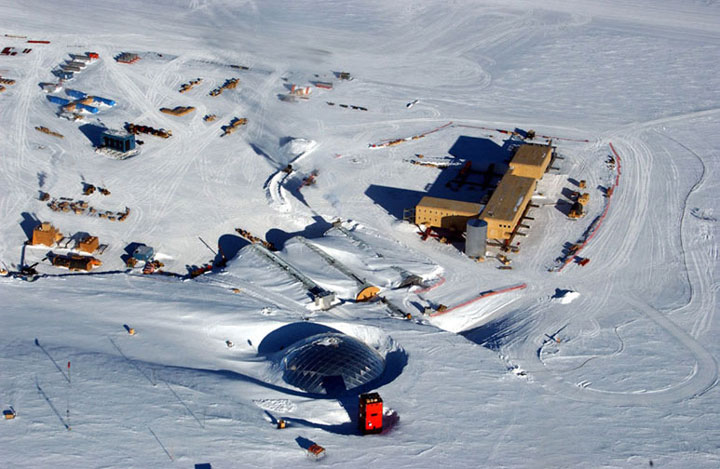

Back at the South Pole - October 25, 2003
It felt good to be back at the pole, flying in on the first LC-130
flight of the season. It was about -65oF and everything
looked about the same with the exception of the new elevated station.
Two years of progress had tripled the size of the station from when I
left 2 years earlier. In fact, the first module, nearest to the shiny
aluminum clad "beer can" was now inhabited and contained 40 berthing
rooms and a new galley with windows.
The "beer can" is the cylindrical structure that contains the 13
flights
of
stairs or 92 steps from the tunnel level to the second floor galley.
Most
people walk up these 92 steps many times a day, and at a pressure
altitude
of between 10,500 ft and 11,500 ft, it can make one quite winded. For
me, I decided to choose a room in upper berthing in the dome. I like
the dome and it is near much of my work. Two of my laboratories are in
the first two floors of skylab, the orange tower, which is connected to
the dome through an under ice tunnel. I may choose to live in the
new
elevated station for winter. I'll make that decision later. I also have
a building in the Dark Sector, one kilometer away and a lab in the
Atmospheric Research Observatory (ARO), about 1/2 kilometer away. ARO
is where the camera is that takes live images of the station. (See link
below)
A month before leaving for New Zealand, the 2004 winterover group
attended an Outward Bound Course at 10,000 ft in the Rockies in
Leadville, Colorado. This is where we first got to know the people we
would be working closely with for over a year. After the Outward Bound
Course we all attended a fire fighting school at the Rocky Mountain
Fire Academy in Denver. Here, we learned basic fire fighting skills,
how to work with each other, and how to perform search and rescue. Fire
is a
serious matter at the South Pole because of the extreme isolation, the
lack of water, and temperatures that can drop into the -110's
Fahrenheit. Training includes fire fighting with water, although
we don't have that option at the Pole; only fire extinguishers, dry
chem and carbon dioxide basic
extinguisher technique bunkered up with
MSA air packs(photo by Sean Ryan)
cooling off after search and
rescue in the burn building team fighting a
propane tank fire(photo
by Sean Ryan) repelling
On October 13th, I left Rhode Island for Christchurch, New Zealand.
There, I met up with many of my fellow winterovers as well as other
friends I had met years earlier. New Zealand is a beautiful country and
it was nice to spend several days there. On October 18th, the flight
from Christchurch, New Zealand to McMurdo Station,
Ross Island, Antarctica was much nicer than in previous years thanks to
a flight in
a C-17 transport, instead of a C-141 or an LC-130. There was quite a
lot of legroom compared to the other aircraft. C-17 flight.
Once we got to McMurdo Station we had additional fire training
before
leaving for the pole on an LC-130. Before leaving for the South Pole
some of us did get the opportunity
to take a trip out to Cape Evans over the sea ice on a large-wheeled
Delta vehicle. two deltas at cape Evans
After the 2 hour ride we left the delta and visited Scott's Hut where
the ill fated expedition to the South Pole was staged from.
scott's hut
The inside of the building has been preserved the way it was left by
Scott when the team left for the pole. dining table
Near the hut is a hill with a commemorative cross for the men who lost
their lives. cross
At the edge of the sea ice you can see the edge of the glacier that is
moving down from Mount Erebus Scott's hut with Erebus
glaciers
On the trip back to McMurdo Station, we saw a rare sight. A group of
Emperor
Penguins crossing the Ross Sea ice came over to our vehicle and the
crossed in
front of us. It was an interesting sight. Curious Emperor Penguins
On October 25, most of the winterover group left on the first LC-130
aircraft of the season to the South Pole to begin our 13 month stay..
A Real-Time Photo of South Pole Station as Seen from the ARO Building (live when satellite is up)
A Comprehensive
South Pole Web Site by Bill Spindler
Winterover Web Pages
(Bill Spindler's List)
SOUTH
POLE 2003-2004 HOME PAGE